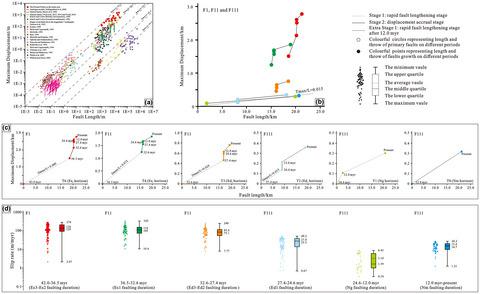当前位置:
X-MOL 学术
›
Basin Res.
›
论文详情
Our official English website, www.x-mol.net, welcomes your
feedback! (Note: you will need to create a separate account there.)
Growth and linkage of normal faults experiencing multiple non-coaxial extension: A case from the Qikou Sag, Bohai Bay Basin, East China
Basin Research ( IF 2.8 ) Pub Date : 2021-11-25 , DOI: 10.1111/bre.12639 Shunyu Wang 1 , Keyu Liu 1 , Haixue Wang 2 , Meiyi Chen 3
Basin Research ( IF 2.8 ) Pub Date : 2021-11-25 , DOI: 10.1111/bre.12639 Shunyu Wang 1 , Keyu Liu 1 , Haixue Wang 2 , Meiyi Chen 3
Affiliation

|
Oblique-slip faults, which are essentially reactivated pre-existing fault caused by non-coaxial stress, are common in rift basins. Large faults with lengths exceeding thousands of kilometres are mostly rooted faults and would have experienced numerous reactivations. Using 3D seismic and drilling data, we investigated the geometry, kinematic features, growth and linkage, and three-dimensional evolution of the Nandagang fault system (NDGFS) on the Qinan Slope in the Qikou Sag, Bohai Bay Basin. A hybrid fault model incorporating a lengthening stage and a displacement accrual stage was used to analyse the growth and linkage of NDGFS. By using the throw/displacement backstripping approach, ratios of maximum displacement to fault length (Dmax/L) of the evolving NDGFS were also obtained to delineate faulting stages of the hybrid fault model. From the pre-Cenozoic basement to the Quaternary strata, NDGFS comprises three fault systems separated vertically by two unconformities, namely the lower, the middle and the upper systems. On planar view, NDGFS encompasses three structural trending zones with variable vertical growth styles. The E–W and NEE–SWW trending zones are mainly dominated by growth faults, while the NE–SW zones are characterised by dip-linkage faults. For NDGFS, both the middle and deeper fault segments experienced a two-stage hybrid faulting and reached their final lengths in ca. 20%–30% less time than the usual faulting lifetime proposed by previous researchers. In contrast, the upper faults, especially the segments within the Neogene Guantao (Ng) and Minghuazhen (Nm) formations, only experienced a lengthening stage. The slip rates and the pre-existing faults have strong influences on the duration that faults accomplished their lengthening stages. A Dmax/L ratio of 0.015 obtained from the evolving NDGFS is determined to be effective in delineating between the lengthening stage and the displacement accrual stage, which may have a broad application for normal faults in similar geological settings.
中文翻译:

多次非同轴伸展正断层的生长与联动——以渤海湾盆地歧口凹陷为例
斜滑断层本质上是由非同轴应力引起的预先存在的断层重新激活,在裂谷盆地中很常见。长度超过数千公里的大型断层大多是根断层,并且会经历多次重新激活。利用三维地震和钻井数据,我们研究了渤海湾盆地歧口凹陷启南斜坡南大港断裂系(NDGFS)的几何形状、运动学特征、生长和联结以及三维演化。结合拉长阶段和位移应计阶段的混合断层模型用于分析NDGFS的增长和联系。通过使用投掷/位移反剥离方法,最大位移与故障长度的比值 ( D max / L) 的演化 NDGFS 也被用来描绘混合断层模型的断层阶段。从前新生代基底到第四纪地层,NDGFS由下、中、上两个不整合面垂直分隔的三个断层系统组成。从平面上看,NDGFS 包含三个具有可变垂直增长方式的结构趋势区。E—W和NEE—SWW走向区以生长断层为主,NE—SW走向区以倾连断层为特征。对于 NDGFS,中部和深部断层段都经历了两阶段混合断层,并在 ca 达到最终长度。比以前研究人员提出的通常故障寿命缩短 20%–30%。相比之下,上层断层,尤其是新近纪馆陶(Ng)组和明化镇(Nm)组内的段,仅经历了拉长阶段。滑动率和预先存在的断层对断层完成延长阶段的持续时间有很大的影响。一种从演化的 NDGFS 中获得的 0.015 的D max / L比率被确定为在延长阶段和位移积累阶段之间划定有效,这可能对类似地质环境中的正断层具有广泛的应用。
更新日期:2021-11-25
中文翻译:

多次非同轴伸展正断层的生长与联动——以渤海湾盆地歧口凹陷为例
斜滑断层本质上是由非同轴应力引起的预先存在的断层重新激活,在裂谷盆地中很常见。长度超过数千公里的大型断层大多是根断层,并且会经历多次重新激活。利用三维地震和钻井数据,我们研究了渤海湾盆地歧口凹陷启南斜坡南大港断裂系(NDGFS)的几何形状、运动学特征、生长和联结以及三维演化。结合拉长阶段和位移应计阶段的混合断层模型用于分析NDGFS的增长和联系。通过使用投掷/位移反剥离方法,最大位移与故障长度的比值 ( D max / L) 的演化 NDGFS 也被用来描绘混合断层模型的断层阶段。从前新生代基底到第四纪地层,NDGFS由下、中、上两个不整合面垂直分隔的三个断层系统组成。从平面上看,NDGFS 包含三个具有可变垂直增长方式的结构趋势区。E—W和NEE—SWW走向区以生长断层为主,NE—SW走向区以倾连断层为特征。对于 NDGFS,中部和深部断层段都经历了两阶段混合断层,并在 ca 达到最终长度。比以前研究人员提出的通常故障寿命缩短 20%–30%。相比之下,上层断层,尤其是新近纪馆陶(Ng)组和明化镇(Nm)组内的段,仅经历了拉长阶段。滑动率和预先存在的断层对断层完成延长阶段的持续时间有很大的影响。一种从演化的 NDGFS 中获得的 0.015 的D max / L比率被确定为在延长阶段和位移积累阶段之间划定有效,这可能对类似地质环境中的正断层具有广泛的应用。











































 京公网安备 11010802027423号
京公网安备 11010802027423号